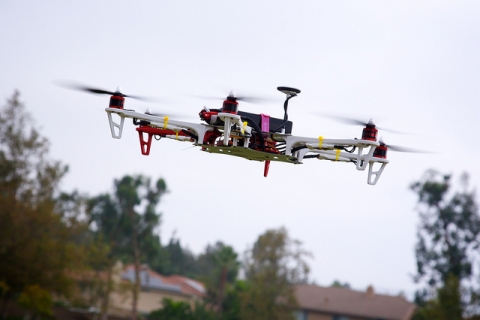
Drones, like the "hexacopter" above, have great potential for journalists, but governments are struggling to keep pace.
But there are many hurdles to clear as governments struggle to keep pace with the new technology and its adoption by the media industry.
“We’re living at a time that innovation is coming on at a much faster rate than regulation,” said Kenyan journalist Dickens Olewe, winner of the African News Innovation Challenge, which was launched by the African Media Initiative under the leadership of ICFJ Knight Fellow Justin Arenstein.
Olewe, who founded the first drone journalism project in Africa, AfricanSkyCAM, recently spoke on a panel moderated by ICFJ President Joyce Barnathan at the recent World Editors Forum held in Washington, D.C. They were joined by Niko Chauls, Director of Applied Technology at Gannett Digital, and Anders Kring, head of Berlingske Media LAB in Denmark. In addition to drones, the “Into the Future” panel examined how wearable technology and virtual reality will matter in tomorrow’s journalism.
As drones prove more useful in journalism, governments are cracking down on reporters. Authorities questioned an NBC news crew in Nepal after they captured drone footage of the recent earthquake devastation. Now the country’s aviation authority has to grant permission to all drone operators ahead of time. Al Jazeera journalists were arrested in Paris for flying drones around historical landmarks. Drones are also banned in Kenya, Cambodia, Uganda, Morocco and other countries.
These challenges can be traced back to a “perception problem” that’s largely fueled by the media, said Olewe, a recent John S. Knight Journalism Fellow at Stanford University.
“Every time you hear about drones, you hear that someone was trying to spy on someone, or that there was a near-crash,” he said, citing that the media’s coverage of UAVs leads to fear and misunderstanding of the new technology.
Yet drones prove useful for ensuring editorial independence. For example, when Kenya faced massive floods in 2013, reporters could usually gain an overhead view of the damage only by riding in government helicopters, which could dictate not only what they see from above, but also the resulting coverage. Olewe decided to get an eye on the situation himself by flying a drone above the damaged areas, ensuring that the footage shown to citizens captured the whole story.
The Kenyan government has since placed tight restrictions on drones, with aspiring users needing a permit to operate. The paperwork-ridden process costs nearly US$1,000 in fees.
As tensions mount, Olewe suggests collaboration rather than confrontation between governments and drone users.
He also suggested that newsrooms pool resources, rather than each one having its own drone in the sky. If there is one body in charge of collecting drone footage, newsrooms could share this content. “That’s how you start to monitor this space. That’s how you start dealing with the privacy and the security issues,” Olewe said.
As part of his fellowship, Olewe organized a conference on drone journalism with the Center for Investigative Reporting and News Lab at Google. The event brought together journalists, lawyers, techies and others to discuss cases of drones in news, the regulation problem and the technology’s future.
Olewe said he wants to organize another conference uniting African governments, lawyers and others to discuss the integration of this tech into the civic space.
The best way to ensure that drones secure a legal and accepted footing in today’s society is by being part of the conversation now when the government is talking about rules and policies, Olewe said.
Main image CC-licensed by Flickr via Richard Unten.